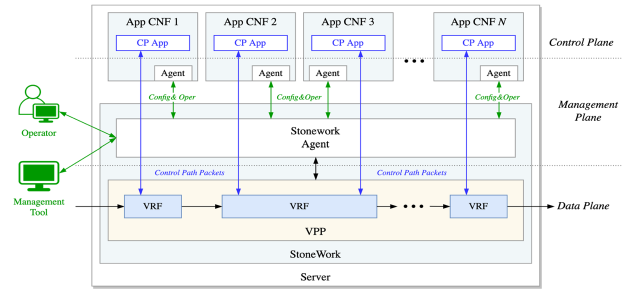In traditional network setups, the issue of network scalability becomes a significant challenge as networks grow and new services are introduced. The usual approach often involves setting up separate physical hardware for each new network or service, resulting in increased costs and inefficiencies in resource usage.
Typically, all the network traffic is managed within a single routing instance, making it challenging to ensure proper isolation and security between different parts of the network.
This lack of isolation and security is a significant concern, particularly in situations where multiple entities (such as different departments, customers, or business units) share the same physical infrastructure but require secure and isolated communication.
Virtual Routing and Forwarding (VRF)
VRF is a technology used in computer networking to create multiple virtual routing instances in a single physical network device, such as a router or a switch.
As networks expand, VRF presents valuable advantages in terms of scalability and security. Instead of adding physical infrastructure for new networks, VRF offers a more efficient approach.
VRF allows multiple virtual routing instances to coexist on the same physical infrastructure, enabling network administrators to create separate and isolated environments without the need for additional hardware.
The isolation provided by VRFs ensures that data flows are distinct and secure between different virtual routing instances. By segmenting the network with VRFs, administrators can apply access control and firewall rules between routing instances, ensuring data privacy and preventing unauthorized access.
Segmentation is particularly crucial in scenarios where interconnecting customers’ branch offices or different business units requires secure communication without interference from other parts of the network. This enhances the overall security of the network, mitigating potential risks and vulnerabilities.
Moreover, VRFs facilitate the implementation of VPNs (Virtual Private Networks), enabling secure communication between different locations and remote offices. This capability is instrumental in maintaining secure and encrypted data flows over shared infrastructure, protecting sensitive information from potential threats.
While it’s true that implementing VRFs introduces some complexity in managing virtual routing instances, the benefits of scalability and security outweigh this challenge.
Network administrators can leverage automation and specialized tools to simplify the configuration and monitoring of VRFs, ultimately enhancing network performance and resource utilization in large and complex networks.
Through resource allocation based on the specific requirements of each VRF instance, VRF ensures efficient network performance and cost-effectiveness.
In essence, VRF effectively addresses the challenges of network scalability, security and resource efficiency, empowering network administrators with a robust and streamlined network management solution.
VRF in StoneWork
If you are looking for a platform with Virtual Routing Functions, deployable in public, private or hybrid cloud environments, StoneWork offers a complete and virtualized data path solution that integrates a VPP data-plane and control plane.
By utilizing VRF within StoneWork, you can achieve enhanced network scalability and segmentation, improved security, and efficient routing of traffic within distinct virtual routing contexts.
If you have any questions, you can send us an email.
You can find the VRF configuration example in StoneWork used as a virtual multi-tenant router on our github here. Each customer/tenant has its own VLAN memif subinterface and VRF table which enables multi-tenancy and routing configurations to be separate for each customer.
StoneWork leverages VRF (Virtual Routing and Forwarding) and VPP (Vector Packet Processing) to provide advanced routing and forwarding capabilities, is easy to implement, and operates in multiple network domains.




![[What Is] VLAN & VXLAN](https://pantheontech1.b-cdn.net/wp-content/uploads/2025/04/vxlan-vpp-thumb-400x250.png)
![[What Is] Whitebox Networking?](https://pantheontech1.b-cdn.net/wp-content/uploads/2025/03/whitebox-net-thumb-400x250.png)
![[What Is] BGP EVPN?](https://pantheontech1.b-cdn.net/wp-content/uploads/2025/03/bgp-evpn-thumb-400x250.png)